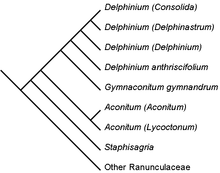Delphinieae
| Delphinieae | |
|---|---|

| |
| Delphinium nuttallianum | |
| Scientific classification | |
| Kingdom: | Plantae |
| Clade: | Tracheophytes |
| Clade: | Angiosperms |
| Clade: | Eudicots |
| Order: | Ranunculales |
| Family: | Ranunculaceae |
| Subfamily: | Ranunculoideae |
| Tribe: | Delphinieae Schrödinger |
Delphinieae is a tribe of the subfamily Ranunculoideae of the family Ranunculaceae. It comprises 4 genera[1] found in Eurasia, North America, and Africa.[2]
Description[edit]
Some species are perennial, whereas others are annual.[3] The leaves are palmate[4][5][6][7] with alternate (spiral) phyllotaxis.[8] The inflorescences are racemose,[3] typically with blue flowers.[8] The flowers have five sepals[1] and a zygomorphic shape. That is, the flowers are symmetrical in only one plane. In most species, the inner petals, which are reduced[9] and completely enclosed by the sepal whorl, have a pair of nectar spurs that force pollinators to move back and forth in order to get nectar from both spurs.[8] The petals are also dorsally spurred.[1] Flowers tend to have many stamens.[3] Flowers have varying numbers of carpels: 3 in Staphisagria, 3-5 in Aconitum, 6-13 in Gymnaconitum, 1 in Delphinium (Consolida), and 3-5 in other Delphinium. The flowers are protandrous, meaning that they are male before they are female. Additionally, they have herkogamy: the anthers and stigma are spatially separated. In the western Mediterranean, species tend to be xenogamous. Some species are strictly xenogamous. Others, especially annuals or species in the genus Staphisagria, are more able to self-fertilize. Species that self-fertilize more frequently tend to have less complex flowers with fewer stamens and fewer carpels.[3]
Taxonomy[edit]

Before the 21st century, the tribe Delphinieae included the genera Aconitum L., Delphinium L., Consolida (DC.) S. F. Gray, and Aconitella Spach.[10] However, classification has since been revised on the basis of molecular data. Aconitella and Consolida are now considered part of Delphinium. Delphinium subg. Staphisagria is now considered its own genus, Staphisagria. Aconitum gymnandrum has been placed in its own genus, Gymnaconitum.[11]
Nigelleae is the tribe most closely related to Delphinieae.[9] It is estimated that Staphisagria diverged from the rest of the Delphinieae tribe about 32.5 million years ago during the Oligocene.[8]
Distribution[edit]
Species of Delphinieae are found in Eurasia and North America, with some species in Africa[2] Delphinieae have a center of diversity in the Himalayas.[8]
Ecology[edit]
The vast majority of Delphinieae are pollinated by bumblebees, but some species are also pollinated by flies, butterflies and moths, other bees,[3] and (in North America) hummingbirds.[8] Most Aconitum and Delphinium species are highly toxic.[12][13][14] Staphisagria macrosperma is also toxic.[15]
References[edit]
- ^ a b c Novikoff, Andrew V.; Jabbour, Florian (2014). "Floral Anatomy of Delphinieae (Ranunculaceae): Comparing Flower Organization and Vascular Patterns" (PDF). Modern Phytomorphology. 5 (1): 35–44. Retrieved 30 June 2024.
- ^ a b Jabbour, Florian; Renner, Susanne S. (2012). "A phylogeny of Delphinieae (Ranunculaceae) shows that Aconitum is nested within Delphinium and that Late Miocene transition to long life cycles in the Himalayas and Southwest China coincide with bursts in diversification". Molecular Phylogenetics and Evolution. 62 (3): 928–942. doi:10.1016/j.ympev.2011.12.005. PMID 22182994.
- ^ a b c d e Bosch, Maria; Simon, Joan; Molero, Julià; Blanché, Cèsar (2001). "Breeding systems in tribe Delphinieae (Ranunculaceae) in the western Mediterranean area". Flora. 196 (2): 101–113. doi:10.1016/s0367-2530(17)30025-7.
- ^ Warnock, Michael J. "Delphinium". In Flora of North America Editorial Committee (ed.). Flora of North America North of Mexico (FNA). New York and Oxford: Oxford University Press. Retrieved 7 July 2024 – via eFloras.org, Missouri Botanical Garden, St. Louis, MO & Harvard University Herbaria, Cambridge, MA.
- ^ Brink, D.E; Woods, J.A. "Aconitum". In Flora of North America Editorial Committee (ed.). Flora of North America North of Mexico (FNA). New York and Oxford: Oxford University Press. Retrieved 7 July 2024 – via eFloras.org, Missouri Botanical Garden, St. Louis, MO & Harvard University Herbaria, Cambridge, MA.
- ^ Lu, Rui; Wu, Tou; Ya, Shu. "Aconitum subg. Gymnaconitum". Flora of China. Retrieved 7 July 2024 – via eFloras.org, Missouri Botanical Garden, St. Louis, MO & Harvard University Herbaria, Cambridge, MA.
- ^ "Delphinium pictum Willd". Virtual Herbarium of the Western Mediterranean. Retrieved 7 July 2024.
- ^ a b c d e f Jabbour, Florian; Renner, Susanne S. (2012). "Spurs in a Spur: Perianth Evolution in the Delphinieae (Ranunculaceae)". International Journal of Plant Sciences. 173 (9): 1036–1054. doi:10.1086/667613.
- ^ a b Zhao, Huiqi; Liao, Hong; Liu, Shuixian; Zhang, Rui; Dai, Jing; Ma, Pengrui; Wang, Tianpeng; Wang, Meimei; Yuan, Yi; Fu, Xuehao; Cheng, Jie; Duan, Xiaoshan; Xie, Yanru; Zhang, Peng; Kong, Hongzhi; Shan, Hongyan (2023). "Delphinieae flowers originated from the rewiring of interactions between duplicated and diversified floral organ identity and symmetry genes". The Plant Cell. 35 (3): 994–1012. doi:10.1093/plcell/koac368. PMC 10015166. PMID 36560915.
- ^ Bosch, M.; Simon, J.; López-Pujol, J.; Blanché, C. "Delphinieae Chromosome Database". Retrieved 1 July 2024.
- ^ Wang, Wei; Liu, Yang; Yu, Sheng-Xiang; Gao, Tiang-Gang; Chen, Zhi-Duan (2013). "Gymnaconitum, a new genus of Ranunculaceae endemic to the Qinghai-Tibetan Plateau". Taxon. 62 (4): 713–722. doi:10.12705/624.10.
- ^ Viberti F, Raveggi E. "Aconitine: How Poisonous, How Harmful?". flipper e nuvola. Retrieved 5 July 2024.
- ^ Warnock, Michael J. (1993). "Delphinium". In Hickman, James C. (ed.). The Jepson Manual: Higher Plants of California. University and Jepson Herbaria. Retrieved 2012-12-08.
- ^ Olsen, J. D.; Manners, G. D.; Pelletier, S. W. (1990). "Poisonous properties of larkspur (Delphinium spp.)". Collectanea Botanica. 19. Barcelona: 141–151. doi:10.3989/collectbot.1990.v19.122.
- ^ "Delphinium staphisagria L., stavesacre". PFAF Plant Database. Retrieved 2020-09-24.
This article needs additional or more specific categories. (July 2024) |
